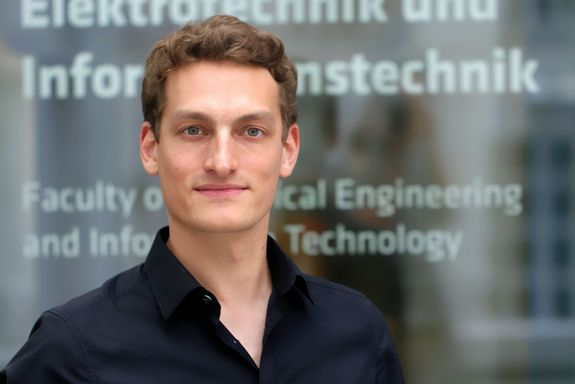The ERC Starting Grant from the European Research Council (ERC) is one of Europe's most lucrative academic awards. Benedikt Schwarz of TU Wien certainly has a right to be delighted with this award, with a value of more than 1 million euros. Having made huge progress in compact laser technologies at the Institute of Solid State Electronics (Faculty of Electrical Engineering and Information Technology), he has already attracted attention in recent years. With the ERC grant, he now wants to develop a compact, portable, energy-efficient laser sensor within the next five years, which can be used to provide evidence of various chemical substances. This should enable measuring devices no bigger than a mobile phone to be produced, which can be used to provide evidence of environmental pollutants or even diagnose illnesses.
Sensor technology in your back pocket
A simple laser pointer emits light of a certain specific frequency, although there are also more complex lasers that generate many different light frequencies. "In our research group, we are working with frequency combs - that is a laser beam that consists of hundreds of different frequencies. So, just like the distance between the teeth of a comb is always the same, the distance between two neighbouring frequencies of the laser beam is also always the same," explains Benedikt Schwarz.
Frequency combs are nothing new: in 2005, Theodor Hänsch won the Nobel Prize for this invention. However, these first frequency combs could only be produced with large, complex laboratory equipment. "Our aim is to produce these frequency combs with another quite different, much more compact technology and to develop a sensor technology from it, which can be integrated onto a chip just a few millimetres in size."
In his dissertation, Schwarz was already laying important foundations for miniaturised sensors. For two years, his team has been researching new frequency technologies that can be miniaturised, with publications in distinguished specialist journals such as "Nature Photonics" and "Optica". The frequency comb technology presented in June 2019 manages without any movable mirrors or other mechanical parts, it can be accommodated on an area of just a few millimetres and at just 1-2 watts, it requires significantly less electrical power than previous systems that have required complex cooling.
The laser beam in gas sampling
This should enable new chemical sensors: "We are using two frequency combs at the same time, with minimally different distances between the individual frequencies," explains Benedikt Schwarz. "These frequencies overlap each other on a detector and thus generate a characteristic signal that we can measure." However, if the laser beam can now be deflected by a gas sample, the molecules of the gas can absorb very specific frequencies. Depending on which gas is involved, different frequencies are strongly absorbed at varying levels. As a result, the signal on the detector also changes, thus enabling us to determine which types of molecule were present in the gas sample.
The list of possible applications for this kind of technology is a long one - from providing evidence of environmental pollutants to medicine: "We now know that a range of illnesses, including cancer, can be detected from a person's breath," says Benedikt Schwarz. "There is a long way to go before we have a simple, compact measuring device in which a person only has to breathe to obtain an important diagnosis. However, it would undoubtedly be a major breakthrough for medicine. In the coming years, we want to improve laser sensor technology to the point where we have a finished prototype at the end of our project that can then be used to support medical research."
Benedikt Schwarz
Benedikt Schwarz grew up in the Tyrol. In 2007, he embarked on his electrical engineering degree at TU Wien and graduated after four years with a Masters in microelectronics. He was awarded his doctorate by the Institute of Solid State Electronics in 2015. In 2015 he then went to Harvard University in the USA as a visiting researcher, where he continues to work as an associate researcher. In parallel, Schwarz began his own research project at TU Wien in 2016, funded by the Austrian Science Fund (FWF).
His academic achievements have already been acknowledged with numerous awards, including the BMWF Honorary Award, the Photonics21 Student Innovation Award, the INiTS Award and the FACSS Innovation Award. To this, he can now add the ERC grant - a particularly lucrative award.
The ERC Starting Grant will enable Benedikt Schwarz to significantly develop his research activities at TU Wien. The funding is intended to enable young researchers to develop their own European cutting-edge research group.
Relevant original publications
B. Schwarz et al. Optica 6, 890 (2019) , opens an external URL in a new window
J. Hillbrand et al. Nature Photonics 13 , 101 (2019) , opens an external URL in a new window
Contact
Dr. Benedikt Schwarz
Institute of Solid State Physics
TU Wien
Gußhausstraße 25, 1040 Vienna
Phone: +43 1 58801 36214
Email: benedikt.schwarz@tuwien.ac.at
Sender
Dr. Florian Aigner
PR und Marketing
TU Wien
Resselgasse 3, 1040 Vienna
Phone: +43 1 58801 41027
Email: florian.aigner@tuwien.ac.at
